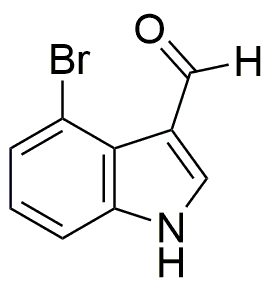4-Bromoindole-3-carboxaldehyde is widely utilized in research focused on:
- Synthesis of Pharmaceuticals: This compound serves as a key intermediate in the synthesis of various pharmaceuticals, particularly in the development of anti-cancer agents and neuroprotective drugs.
- Organic Electronics: It is used in the fabrication of organic light-emitting diodes (OLEDs) and organic solar cells, enhancing the efficiency and stability of these devices.
- Fluorescent Probes: Researchers employ it to create fluorescent probes for biological imaging, allowing for the visualization of cellular processes in real-time.
- Material Science: The compound is explored in the development of advanced materials, such as polymers and coatings, due to its unique electronic properties.
- Biochemical Research: It plays a role in studying enzyme interactions and metabolic pathways, providing insights into various biological processes.
Informations générales
Propriétés
Sécurité et réglementation
Applications
4-Bromoindole-3-carboxaldehyde is widely utilized in research focused on:
- Synthesis of Pharmaceuticals: This compound serves as a key intermediate in the synthesis of various pharmaceuticals, particularly in the development of anti-cancer agents and neuroprotective drugs.
- Organic Electronics: It is used in the fabrication of organic light-emitting diodes (OLEDs) and organic solar cells, enhancing the efficiency and stability of these devices.
- Fluorescent Probes: Researchers employ it to create fluorescent probes for biological imaging, allowing for the visualization of cellular processes in real-time.
- Material Science: The compound is explored in the development of advanced materials, such as polymers and coatings, due to its unique electronic properties.
- Biochemical Research: It plays a role in studying enzyme interactions and metabolic pathways, providing insights into various biological processes.
Documents
Fiches de données de sécurité (FDS)
La FDS fournit des informations de sécurité complètes sur la manipulation, le stockage et l’élimination du produit.
Spécifications du produit (PS)
Le PS fournit une description complète des propriétés du produit, notamment sa composition chimique, son état physique, sa pureté et les exigences de stockage. Il détaille également les plages de qualité acceptables et les applications prévues du produit.
Certificats d'analyse (COA)
Recherchez des certificats d'analyse (COA) en saisissant le numéro de lot du produit. Les numéros de lot et de lot se trouvent sur l'étiquette d'un produit, après les mots « Lot » ou « Lot de fabrication ».
Numéro de catalogue
Numéro de lot/série
Certificats d'origine (COO)
Ce certificat d'exploitation confirme le pays dans lequel le produit a été fabriqué, et détaille également les matériaux et composants utilisés et s'il est issu de sources naturelles, synthétiques ou autres sources spécifiques. Ce certificat peut être requis pour les douanes, le commerce et la conformité réglementaire.
Numéro de catalogue
Numéro de lot/série
Fiches de données de sécurité (FDS)
La FDS fournit des informations de sécurité complètes sur la manipulation, le stockage et l’élimination du produit.
DownloadSpécifications du produit (PS)
Le PS fournit une description complète des propriétés du produit, notamment sa composition chimique, son état physique, sa pureté et les exigences de stockage. Il détaille également les plages de qualité acceptables et les applications prévues du produit.
DownloadCertificats d'analyse (COA)
Recherchez des certificats d'analyse (COA) en saisissant le numéro de lot du produit. Les numéros de lot et de lot se trouvent sur l'étiquette d'un produit, après les mots « Lot » ou « Lot de fabrication ».
Numéro de catalogue
Numéro de lot/série
Certificats d'origine (COO)
Ce certificat d'exploitation confirme le pays dans lequel le produit a été fabriqué, et détaille également les matériaux et composants utilisés et s'il est issu de sources naturelles, synthétiques ou autres sources spécifiques. Ce certificat peut être requis pour les douanes, le commerce et la conformité réglementaire.


